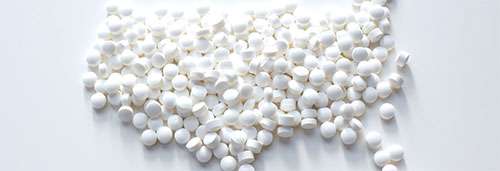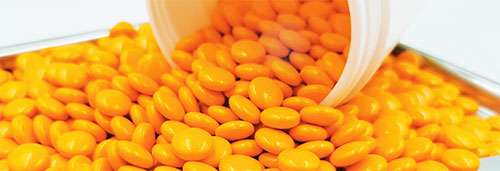Contact Us
- Solutions
- Resources
- About
- Contact Us
close
Optional callout banner for highlighted news or events
Learn More
The flavor taste masking market is expected to jump from $224 million in 2021 to $331 million by 2028.1 One driver behind this increase comes from the pharma industry. According to a recent webinar, Solving the Taste-masking Challenge, more than 90 percent of pediatricians report that a drug’s taste and palatability are the biggest barriers to completing treatment and 11 percent of adverse events relate to abnormal taste or poor aftertaste.
Taste Masking is required for dosage form that interact with the taste buds, such as solutions, suspensions, powders, films, chewable tablets, and orally disintegrating tablets – the preferred dosage forms for pediatric and geriatric populations. Traditional coated tablets, capsules, and soft gels interact minimally with the taste buds as they are swallowed, hence most drugs in these dosage forms do not require taste masking. The best and most practical method of taste masking should be considered for each API. Some of these methods are discussed below.

Flavors and sweeteners (natural or synthetic) are the most common and easiest ways to mask taste, especially in liquid formulas and chewable tablets. Natural sweeteners include sucrose, glucose, fructose, sorbitol, mannitol, glycerol, honey, and liquor ice. Artificial sweeteners include saccharin, saccharin sodium, aspartame, and sucralose. Sweeteners promote a cooling sensation on the esophageal surface, Note: This method is not very effective for very bitter and water-soluble drugs.

Lipids have found extensive use as functional excipients in taste masking because:
Selecting a lipid depends on its physiochemical properties and the desired quality of the dosage form. Lipid membrane taste sensors have been widely used in assessing taste and palatability of pharmaceutical formulations using electronic tongue (e-tongue).2

Complexation is especially applicable for liquid products (e.g. cyclodextrins, ion exchange resins). The purpose of the complexing agent is to mask the unpleasant taste of specific drug either by reducing its oral solubility or reducing the amount of the drug particles interacting with taste buds. One of the most popular approaches in the masking of the taste of bitter drugs is based on ion exchange resin complexes (IER). IER are the polyelectrolytes of the high molecular weight of solids, and, in a suitable insoluble form, can exchange their ions in movement the load equal to the surrounding medium.3 According to webinar, IER enables more flexible formulation of a bitter API. Generally, a weak cation or anion exchange resin is used for taste masking purposes so that the loosely bound drug is released in the gastrointestinal tract.
With complexation, IERs binds or exchange ions with the polymer, but does not necessarily engulf the molecule. With inclusion complexation, on the other hand, there is hydrophobic interaction between the API and the donut shaped cyclodextrin, which acts as the host and engulfs the API to prevent its exposure to the bulk solution. The complexing agent masks the bitter taste of the drug by either decreasing its oral solubility upon ingestion or decreasing the amount of drug particles exposed to taste buds, thereby reducing the perception of bitter taste. This method is most suitable for low dose drugs.4

A coating or granulation prevents interaction of the harsh tasting medicine by blocking the drug contact with the taste buds in mouth. These taste maskers offer a physical wall around the medicine, and can be applied using:

Masking the bitter taste of the drug using multiple emulsions technique is also a good approach. This technique is achieved by dissolving the active pharmaceutical ingredient in the inner aqueous phase of w/o/w emulsion. The internal aqueous phase and the external aqueous phase are separated by the oil phase. Another type is o/w/o emulsion, in which water globules contain oil globules. The effectiveness of masking the bitter taste using both types of multiple emulsions is high.8

No matter the taste masking method chosen, a skilled contract development and manufacturing organization (CDMO) will take the following into account as they formulate the ideal taste masker for an API3:
Most importantly, keep in mind that the appropriate choice of masking substance completely hides, anesthetizes, or changes the flavor of the sour tasting drug without altering the delivery mechanism of the drug. It is important to partner with an experienced CDMO that has the masking methods, uses state-of-the-art technology, and understands the art and science of taste masking.

Sundeep Sethia joined Pii in September 2018 as Senior Director of Pharmaceutical R&D. He has over 15 years of experience in the pharmaceutical industry.
Dr. Sethia formerly served as the Director of Pharmaceutical R&D at Amneal Pharmaceuticals. Prior to Amneal, he held positions of increasing responsibility at both Teva and Barr Laboratories in R&D. His expertise is in drug development across a broad range of therapeutic areas and dosage forms. He has a proven track record in generic drug development and approvals.
Dr. Sethia received his Ph.D. in Pharmaceutical Sciences from St. John’s University, NY. He earned a Master’s and a Bachelor’s degree in Biotechnology and Pharmacy, respectively from Jadavpur University in India. He has co-authored various peer-reviewed scientific publications and patents/patent applications.
Like what you read? Share with your network: